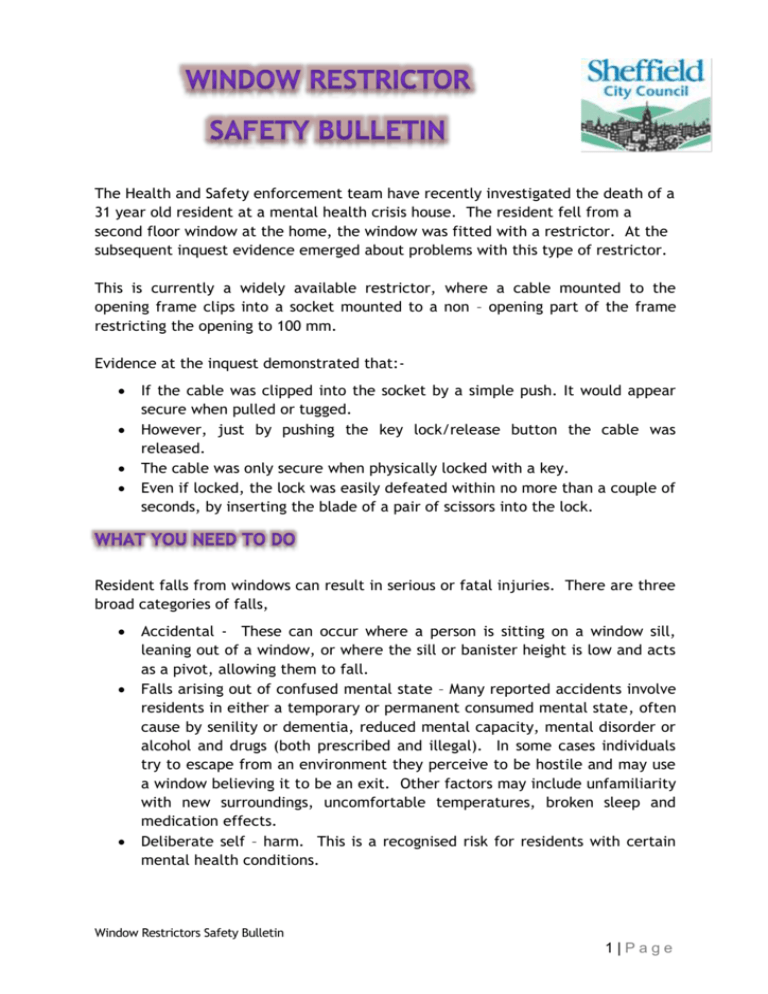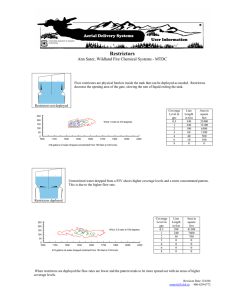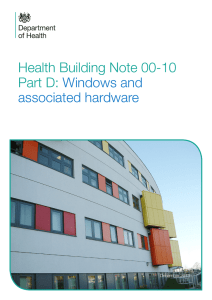Window Restrictor Safety Bulletin
advertisement

The Health and Safety enforcement team have recently investigated the death of a 31 year old resident at a mental health crisis house. The resident fell from a second floor window at the home, the window was fitted with a restrictor. At the subsequent inquest evidence emerged about problems with this type of restrictor. This is currently a widely available restrictor, where a cable mounted to the opening frame clips into a socket mounted to a non – opening part of the frame restricting the opening to 100 mm. Evidence at the inquest demonstrated that: If the cable was clipped into the socket by a simple push. It would appear secure when pulled or tugged. However, just by pushing the key lock/release button the cable was released. The cable was only secure when physically locked with a key. Even if locked, the lock was easily defeated within no more than a couple of seconds, by inserting the blade of a pair of scissors into the lock. Resident falls from windows can result in serious or fatal injuries. There are three broad categories of falls, Accidental - These can occur where a person is sitting on a window sill, leaning out of a window, or where the sill or banister height is low and acts as a pivot, allowing them to fall. Falls arising out of confused mental state – Many reported accidents involve residents in either a temporary or permanent consumed mental state, often cause by senility or dementia, reduced mental capacity, mental disorder or alcohol and drugs (both prescribed and illegal). In some cases individuals try to escape from an environment they perceive to be hostile and may use a window believing it to be an exit. Other factors may include unfamiliarity with new surroundings, uncomfortable temperatures, broken sleep and medication effects. Deliberate self – harm. This is a recognised risk for residents with certain mental health conditions. Window Restrictors Safety Bulletin 1|Page To adequately manage the risk of falls to residents, you may need to assess the risks arising from the premises and any additional risks for individual residents. Where residents are at risk, further measures may be needed to prevent them falling from height. Windows that can be fully opened and are accessible to people at risk of falling or climbing out must meet appropriate standards. In assessing the risks, you should consider furniture, or other items, that may enable residents to climb over barriers, or access windows, which might otherwise be unaccessible. Where necessary, you should provide adequate cooling, eg high-level and/or restricted aperture ventilation, fans or air conditioning where window openings have been restricted. Window restrictors – where vulnerable residents have access to window openings large enough to fall through, and at a height that could cause harm (eg above ground level) those windows should be restrained sufficiently to prevent such falls. Window restrictors should: Restrict the window opening to 100 mm or less; Be suitably robust to withstand foreseeable force applied by an individual determined to open a window further. Where the casement might distort, restrictors should be fitted at both side of the window. Be sufficiently robust to withstand damage (either deliberate or from general wear); Be robustly secured using tamper-proof fittings so they cannot be removed or disengaged using readily accessible implements (such as cutlery, nail files etc). They should require a special tool or key for removal. Windows fitted with initial opening restrictors (no facility to lock) are not suitable in social care premises where individuals are at risk, as they can easily be overridden. Window Restrictors Safety Bulletin 2|Page Window design – The window frames and associated fittings must be sufficiently robust. The Workplace (Health, Safety and Welfare) Regulations 1992 Approved Code of Practice (workplace ACOP) – and Building Regulations – require that the bottom edge of opening windows should normally be at least 800 mm above floor level unless there is a barrier to prevent falls. This will reduce the risk of inadvertent falls where fully openable windows are assessed as being appropriate. HSE’s webpage on falls from windows www.hse.gov.uk/healthservices/falls-windows.htm Health Building Note 00-10 Part D ‘Windows and associated hardware’ Department of Health www.dhsspsni.gov.uk/hbn00-01-partd.pdf Fire Safety Risk Assessment for Residential Care Premises. Department for Communities and Local Government. www.communities.gov.uk/publications/firesafety Workplace (Health, Safety and Welfare) Regulations 1992 L24 HSE Books 2013 ISBN 978 0717665839 Window Restrictors Safety Bulletin 3|Page Window Restrictors Safety Bulletin 4|Page










